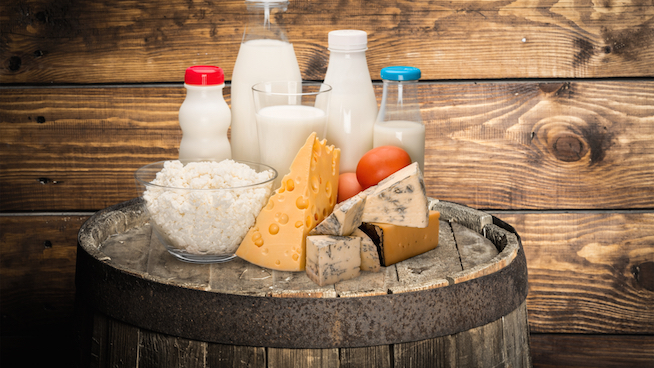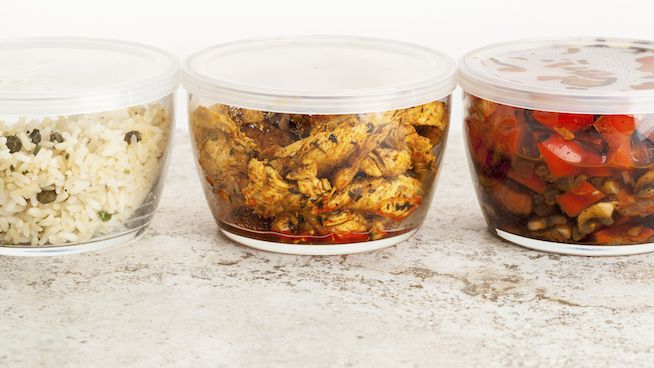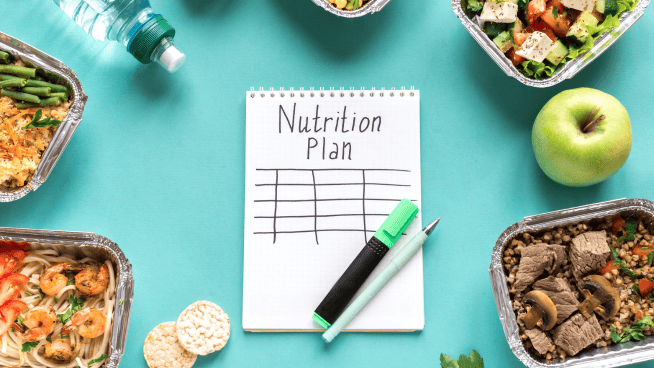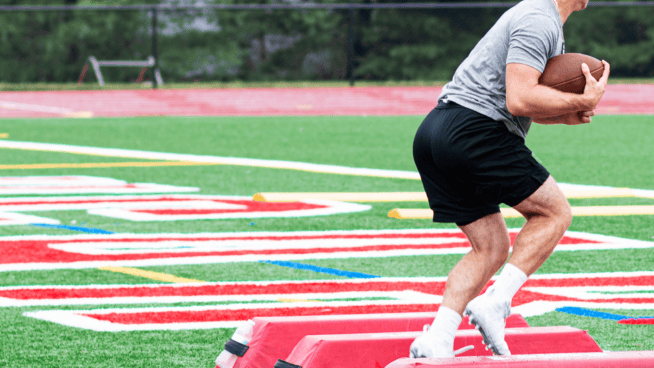The 4 Most Important Sports Nutrition Rules for Athletes
A lesson in elementary school that really resonated with me was when we were given a large jar and 10 or so rocks of various sizes to fit inside it. At first glance, you’d think there was no way you could get the larger rocks to fit with the smaller ones. But, if you started with the big ones and let the small ones fit around them, you could make it work.
The same goes for sports nutrition.
Athletes need to understand that the big rocks need to go in the jar first, and let the pebbles settle around them. This metaphor can help athletes juggle their busy schedules of practices, games, lifting, school and a social life.
This metaphor will also help nail down any sports nutrition plan. Unless you’re a pro athlete, nutrition plans don’t need to be highly complex and intricate to yield quality results. Instead, if an athlete can get the “big rocks” to fit into the jar, the rest will fall into place.
Here are the 4 rocks for an athlete’s nutrition plan:
1. Accountability
Most athletes are highly motivated and committed to their sports and athletic lifestyle. It’s in their DNA. But that doesn’t mean nutrition should take a back seat. The first thing athletes need to ask themselves is if they’re ready to commit to fine-tuning their nutrition plan. Most athletes are confident in their abilities on the field, but it’s imperative for them to be confident in changing their lifestyle to a healthy one. That comes with consistency.
Another way athletes can know they’re ready to carry out a healthy meal plan is by committing to a schedule that prioritizes meal prep. Creating an integrated system that works for each individual athlete is essential. Such a system allows the athlete to plan ahead, stay accountable with meal prep rituals and achieve success long term.
But, within that system an athlete needs to understand there will be bumps in the road due to their busy lifestyle. Unless you’re a professional athlete, chances are you don’t have a private chef. Always remember, a consistent B effort is better than one week of A+ and 3 weeks of Ds.
2. Eat for your sport
The sport you play will dictate what your nutrition plan will look like. Different sports require different energy intakes and seasonal differences. Mid-season may require more recovery and anti-inflammatory foods, while the offseason will call for higher protein intake due to a larger volume of strength training. The main takeaway should be “eat what you burn.”
Unless you’re trying to make weight or need to drop pounds for a sport-specific reason, failing to refuel your body properly will eventually lead to a decrease in athletic performance.
Athletes should always be looking at what they are eating before, during and after games.
Pre-game nutrition directly affects your performance on the field. If athletes don’t properly fuel up 2-3 hours before game time, their blood sugar levels could be low, directly affecting coordination, endurance and overall focus.
Mid-game nutrition also varies depending on the sport, but it’s also essential. For example, soccer players playing a 90-minute match burn tons of calories and deplete a high percentage of their muscle glucose throughout a game. At any point, they should be reaching for a drink high in electrolytes, sodium and fast-acting carbs to refuel their muscles and give them the endurance they need. Generally, this is where a sports drink comes into play.
Post-game nutrition could be the most important in terms of recovery and long-term success. The mindset of most athletes after a game is that they can eat anything. Wherever the bus takes them, a glutton for food comes out. But if they choose chicken nuggets and French fries over lean protein and smart carbs, they could be more inflamed and sore, and not reap the benefits of their workout or game. This rolls into the accountability portion of the big rocks. If the athlete knows the bus is headed to a fast food joint post-game, he or she should plan to bring high quality protein shake onto the bus.
3. Nail your macros down
It’s no secret that athletes need more calories. Each day, the energy output of athletes is much higher than that of everyday people. During practices, games or an offseason workout, an athlete can burn anywhere from 800 to 1,500 calories, and if they are not replaced, the athlete’s body will suffer. Without getting too complicated with macros, athletes should think about each meal and what it should contain.
Every meal should have 1-2 serving of lean protein, 1 serving of colorful vegetables or fruit, and 1-2 servings of a healthy fat.
Most meals should also include a slow-digesting, high-fiber carb such as brown rice, quinoa, oats or lentils. The slow-digesting carb should be eaten either in the morning or around game—to ensures that the carbs will replace any lost muscle glycogen.
Follow this meal plan, and the macros will be on point and aid in building muscle, endurance training and overall good health. This may seem like an impossible task for busy athletes always on the go. But even when you’re on the road, you should still try to abide by these macro principals at each meal.
But sometimes that’s just not realistic, and you need to swing into a convenience store for a quick pick-me-up before or after a game. When that happens . . .
4. Eat real food, not sport food
No matter where you are, you can get food with nutritional value. Even gas stations carry health bars that are high in smart carbs and protein—great options for the athlete on the go.
Athletes need better quality food than average people. Regardless of the food and no matter what the athlete is ingesting, it needs to hold nutritional value. If not, the body won’t recover quickly and muscle synthesis could turn into degradation. As a general rule, stay away from self proclaimed “fitness foods” like energy drinks, “Paleo packs” and bars with chapter-long lists of ingredients.
Generally this stuff is a cornucopia of processed and often poor quality food, leading to subpar choices. Part of being an athlete means you have to understand the importance of nutrient rich foods and how they affect your performance. All athletes should treat their body as a temple where chemical-filled foods don’t belong.
Good whole food alternatives almost as good as prepared meals but more convenient are everywhere. Choosing whole grain bread over white, a bag of trail mix over chips, or a bar with fewer than 10 ingredients and 10 g of sugar are all available at any quick stop or sandwich chain. Now more than ever, it’s easy to make healthy choices, so if athletes can consciously make those choice, they’ll be golden.
If an athlete can nail down these big rocks of nutrition, only then can they move on to a more complex, individualized plan. Athletes shouldn’t have to do this alone either. Get teammates, coaches and parents involved and create an atmosphere where performance nutrition can thrive. Everyone commits hours of practice to better the team’s chance at a W. Commit some of that time to nutrition, and it will put the team one step ahead of the competition.
READ MORE:
RECOMMENDED FOR YOU
MOST POPULAR
The 4 Most Important Sports Nutrition Rules for Athletes
A lesson in elementary school that really resonated with me was when we were given a large jar and 10 or so rocks of various sizes to fit inside it. At first glance, you’d think there was no way you could get the larger rocks to fit with the smaller ones. But, if you started with the big ones and let the small ones fit around them, you could make it work.
The same goes for sports nutrition.
Athletes need to understand that the big rocks need to go in the jar first, and let the pebbles settle around them. This metaphor can help athletes juggle their busy schedules of practices, games, lifting, school and a social life.
This metaphor will also help nail down any sports nutrition plan. Unless you’re a pro athlete, nutrition plans don’t need to be highly complex and intricate to yield quality results. Instead, if an athlete can get the “big rocks” to fit into the jar, the rest will fall into place.
Here are the 4 rocks for an athlete’s nutrition plan:
1. Accountability
Most athletes are highly motivated and committed to their sports and athletic lifestyle. It’s in their DNA. But that doesn’t mean nutrition should take a back seat. The first thing athletes need to ask themselves is if they’re ready to commit to fine-tuning their nutrition plan. Most athletes are confident in their abilities on the field, but it’s imperative for them to be confident in changing their lifestyle to a healthy one. That comes with consistency.
Another way athletes can know they’re ready to carry out a healthy meal plan is by committing to a schedule that prioritizes meal prep. Creating an integrated system that works for each individual athlete is essential. Such a system allows the athlete to plan ahead, stay accountable with meal prep rituals and achieve success long term.
But, within that system an athlete needs to understand there will be bumps in the road due to their busy lifestyle. Unless you’re a professional athlete, chances are you don’t have a private chef. Always remember, a consistent B effort is better than one week of A+ and 3 weeks of Ds.
2. Eat for your sport
The sport you play will dictate what your nutrition plan will look like. Different sports require different energy intakes and seasonal differences. Mid-season may require more recovery and anti-inflammatory foods, while the offseason will call for higher protein intake due to a larger volume of strength training. The main takeaway should be “eat what you burn.”
Unless you’re trying to make weight or need to drop pounds for a sport-specific reason, failing to refuel your body properly will eventually lead to a decrease in athletic performance.
Athletes should always be looking at what they are eating before, during and after games.
Pre-game nutrition directly affects your performance on the field. If athletes don’t properly fuel up 2-3 hours before game time, their blood sugar levels could be low, directly affecting coordination, endurance and overall focus.
Mid-game nutrition also varies depending on the sport, but it’s also essential. For example, soccer players playing a 90-minute match burn tons of calories and deplete a high percentage of their muscle glucose throughout a game. At any point, they should be reaching for a drink high in electrolytes, sodium and fast-acting carbs to refuel their muscles and give them the endurance they need. Generally, this is where a sports drink comes into play.
Post-game nutrition could be the most important in terms of recovery and long-term success. The mindset of most athletes after a game is that they can eat anything. Wherever the bus takes them, a glutton for food comes out. But if they choose chicken nuggets and French fries over lean protein and smart carbs, they could be more inflamed and sore, and not reap the benefits of their workout or game. This rolls into the accountability portion of the big rocks. If the athlete knows the bus is headed to a fast food joint post-game, he or she should plan to bring high quality protein shake onto the bus.
3. Nail your macros down
It’s no secret that athletes need more calories. Each day, the energy output of athletes is much higher than that of everyday people. During practices, games or an offseason workout, an athlete can burn anywhere from 800 to 1,500 calories, and if they are not replaced, the athlete’s body will suffer. Without getting too complicated with macros, athletes should think about each meal and what it should contain.
Every meal should have 1-2 serving of lean protein, 1 serving of colorful vegetables or fruit, and 1-2 servings of a healthy fat.
Most meals should also include a slow-digesting, high-fiber carb such as brown rice, quinoa, oats or lentils. The slow-digesting carb should be eaten either in the morning or around game—to ensures that the carbs will replace any lost muscle glycogen.
Follow this meal plan, and the macros will be on point and aid in building muscle, endurance training and overall good health. This may seem like an impossible task for busy athletes always on the go. But even when you’re on the road, you should still try to abide by these macro principals at each meal.
But sometimes that’s just not realistic, and you need to swing into a convenience store for a quick pick-me-up before or after a game. When that happens . . .
4. Eat real food, not sport food
No matter where you are, you can get food with nutritional value. Even gas stations carry health bars that are high in smart carbs and protein—great options for the athlete on the go.
Athletes need better quality food than average people. Regardless of the food and no matter what the athlete is ingesting, it needs to hold nutritional value. If not, the body won’t recover quickly and muscle synthesis could turn into degradation. As a general rule, stay away from self proclaimed “fitness foods” like energy drinks, “Paleo packs” and bars with chapter-long lists of ingredients.
Generally this stuff is a cornucopia of processed and often poor quality food, leading to subpar choices. Part of being an athlete means you have to understand the importance of nutrient rich foods and how they affect your performance. All athletes should treat their body as a temple where chemical-filled foods don’t belong.
Good whole food alternatives almost as good as prepared meals but more convenient are everywhere. Choosing whole grain bread over white, a bag of trail mix over chips, or a bar with fewer than 10 ingredients and 10 g of sugar are all available at any quick stop or sandwich chain. Now more than ever, it’s easy to make healthy choices, so if athletes can consciously make those choice, they’ll be golden.
If an athlete can nail down these big rocks of nutrition, only then can they move on to a more complex, individualized plan. Athletes shouldn’t have to do this alone either. Get teammates, coaches and parents involved and create an atmosphere where performance nutrition can thrive. Everyone commits hours of practice to better the team’s chance at a W. Commit some of that time to nutrition, and it will put the team one step ahead of the competition.
READ MORE:










